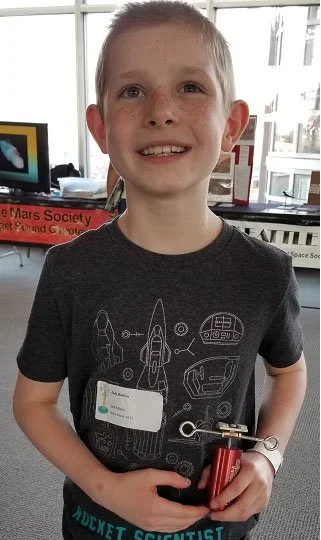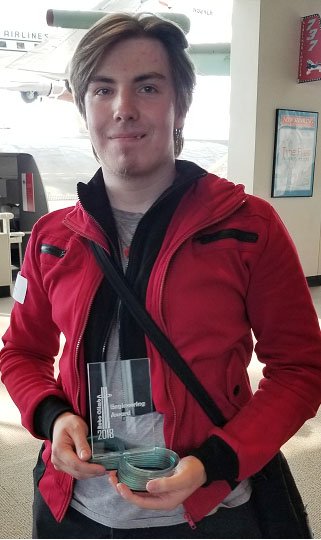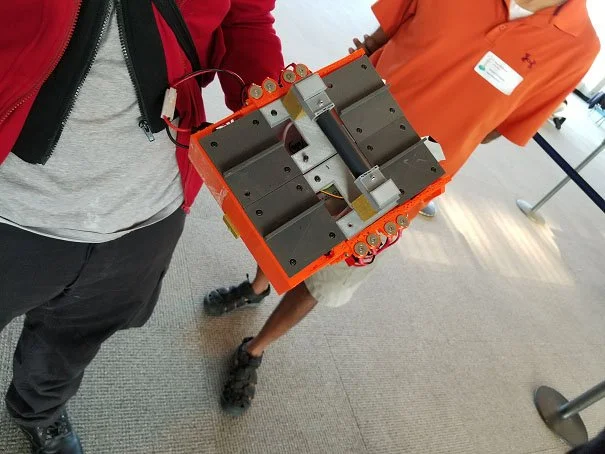International Space Elevator Consortium
September 2018 Newsletter
In this Issue:
Editor’s Note
President's Corner
Conference Recap
Architecture Note #20
Earth Port Update #10
Volunteers Needed
Editor’s Note
Dear Fellow Space Elevator enthusiast,
If you were unable to come to the Space Elevator Conference (SEC) this year, I have a couple of questions for you...why not? and, is there anything keeping you from coming next year? We would love for you to join us. Stay tuned to this newsletter for information about next year's event!
In this edition of the ISEC Newsletter you will read about what went on over the weekend at the SEC and see pictures of young participants in the climber competition. We also have our latest submissions from our Chief Architect and Earth Port Harbor Master...enjoy!
As always, you will find notices of several open volunteer positions (a great way to help this project, even if you’re not a scientist or engineer) and a reminder that all ISEC reports are available FOR FREE in electronic (pdf) format at ISEC.org. There is plenty of work to be done!
If you want to help us make a space elevator happen, JOIN ISEC and get involved! A space elevator would truly revolutionize life on earth and open up the solar system and beyond to all of us.
Please don’t forget to LIKE US on Facebook, FOLLOW US on Twitter, and enjoy the photos and videos that we’ve posted on Flickr and YouTube, all under our Social Identity of ISECdotORG.
Thank you for reading and lending your support in the development of Space Elevators!
Sandee Schaeffer
ISEC
President's Corner
Excitement for Conference
During this year's International Space Elevator Conference I was reminded that we indeed were participating in a project that would change the future of humanity. Dan Gleeson reminded me of a key concept expressed by Daniel Burnham [Wikiquote]:
Make no little plans; they have no magic to stir men's blood and probably themselves will not be realized. Make big plans; aim high in hope and work, remembering that a noble, logical diagram once recorded will never die, but long after we are gone be a living thing, asserting itself with ever-growing insistency.
The recent International Space Elevator Conference's [mid Aug] theme was "The Space Elevator is Closer than you Think!" There were a few significant realizations during the conference that lead to this conclusion. The primary discussions focused upon materials. There is a new material now being developed that WILL enable space elevator tethers. The previous front-runner [carbon nanotubes] has not made significant viable progress. However, single crystal graphene seems to be developing with the principle strength of long-enough and strong-enough for the specific needs of space elevators. It is proposed that the material can be “drawn” off a furnace structure such that the carbon atoms continue to combine as the single molecule is pulled outward - thus building a long single molecule [so far 0.5 meter long and 0.1 meter wide single crystal]. This material has great promise to enable the space elevator. Progress has been made and enthusiasm is back for new material potential. Our conference was very successful and many topics were discussed; but, the major focus [keynote speech and multiple discussions] was on the newly discovered process to produce a single crystal molecule that can be grown continuously. It has great promise for our needs - 100,000 km tether of remarkable strength [greater than 50 GPa and almost perfect which limits tears] The three days of this conference were remarkable and exciting -- we just might be “off and running.” We will see; but, what fun to be on the forefront of a new technology that can lead to a humanity changing development [change from planetary society to a multi-planetary one].
Indeed - we are making big plans while aiming high in hope and work!
Keep Climbing my Friends
Pete
Conference Recap
Pictured, left to right: Phil Richter, Dennis Wright, Ruth Richter, Pete Swan, Thad Heckman, Phil Swan, David Horn, Mark Dodrill, Michael Schaeffer, Sandee Schaeffer, Theresa Tutt, Brian Laubscher, Dan Gleeson, John Knapman, Peter Bahn, Drew Patterson, Doug Alquist, Nigel Sharp, Bert Malloy.
The 2018 ISEC Space Elevator Conference was held at the Museum of Flight in Seattle, WA August 17-19. This year's conference theme was “The Space Elevator Transportation System is closer than you think.” Attendees participated in workshops to help advance the annual ISEC studies and were presented with a wonderful keynote presentation on strong materials development by Adrian Nixon. This year's presentations and workshops included:
Presentations
“The last piece of the puzzle? – Single Crystal Graphene” by Adrian Nixon (Nixor Ltd)
“Building the Space Elevator: Lessons from Biological Design” by Sean Sun and Dan Popescu (Johns Hopkins University)
“One Step Closer to Reality – Achieving Technical and Economic Viability through Innovative Business Models” by Phil Swan and CP Nickel”
“Fuller-Clarke Sphere” by Thad Heckman (Design Works)
“Characteristics of Space Elevator Apex Anchor” by Dr. Pete Swan (ISEC)
“A Hardware Space Elevator Simulator” by Dennis Wright (ISEC)
“Space Elevator Transportation System Baseline” by Michael Fitzgerald (ISEC)
Mini Workshops
The 2018 ISEC Study - “Technical Description of the Multi-Stage Space Elevator” – led by John Knapman (ISEC)
The 2018 theme: The Space Elevator Transportation System is closer than you think - “Preliminary Technology Readiness Assessment of the Space Elevator Transportation System” – led by Michael Fitzgerald (ISEC)
Intro to the 2019 ISEC Study Topic - “ISEC’s Outreach with Early Experimentation support” – led by Dennis Wright (ISEC) and Michael Fitzgerald (ISEC)
Family Science Fest
On the Saturday of the conference was the annual Family Science Fest open to the public with admission to the museum, a family-friendly event with something for everyone including hands-on activities, displays and demonstrations with the focus on STEM (science, technology, engineering and math). Two public talks on space elevators were presented by Dr. Bryan Laubscher and Dr. Peter Swan. The science fest also featured Robo Climb, a youth robotics competition where student-designed robots climb 22 feet in the air while carrying payload, simulating space elevators transporting cargo into space. For the first time ever, we had more Anything Goes robots than LEGO Only robots and most of the Anything Goes robots were built out of unique materials this year. There was a laser cut plywood robot, a 3D printed robot, a robot using a raspberry pi, and several others that were very different from what we’ve had in previous years.
The 2018 Robo Climb winners
LEGO Only robots
1st place: Astrobaut – 147 points
2nd place: Jack Bolton – 15 points (an 8 year old solo competitor)
3rd place: Rolling Jellybean Devils for life – 0 points, but the lightest robot at 1.88 lb
Anything Goes robots
1st place: The Space Invaders – 415 points (laser cut plywood robot)
2nd place: Pi Bots – 355 points (mostly Lego, but with a Raspberry Pi controller on the robot and loader)
3rd place: MechaHawks – 230 points (VEX IQ robot, team built their robot just in the last few days)
Engineering Award
Jesse Keep of Iron Dragon Printing (also a solo competitor) – a completely 3d printed robot (except electronics); used magnets as conductors across the two halves of the robot to reduce wiring issues, and a number of other innovations, including using an AMD Fusion processor. Fastest climb time we’ve ever had!
Team Spirit Award
Pi Bots – not just for being enthusiastic, or wearing team shirts, but because they were engaging, helping, and a very young team (9-12 year olds)
Next year’s conference is tentatively scheduled for August 16-18, 2019, with the Family Science Fest on August 17. Stay tuned to the ISEC web site and newsletters for more information as we lock down the date and venue.
Jack Bolton (8 yr old) Second Place, Lego Competition.
Jesse Keep of Iron Dragon Printing, winner of the Engineering Award
One half of Jesse's climber: note the four magnets on each side to hold the climber together.
Side two of Jesse's climber.
Architecture Note #20
Space Elevator Transportation System Management
Architecture Baseline has been found and A Myriad of Tests and Demonstrations are needed
by Michael A. Fitzgerald, Chief Architect
Personal Prolog
This is an Architecture Note. It is the opinion of ISEC’s Chief Architect. It represents an effort to document ISEC’s ongoing science and engineering discussions, and is one of many to be published over time. Most importantly, it is a sincere effort to be the diary, or the chronicle, of the multitude of our technical considerations as we progress; along the pathway developing the Space Elevator.
The 2018 Conference results from an Architect’s perspective
Introduction
The Year 2017 was a big year. It was so big that it has taken nearly 3/4 of 2018 to get our story straight; and if we could just get people to join with us and our vision; all would be good. Right?
Not really, we need to change or improve a few things and then all would be good. Right? Not really, we will need to change or improve a few more things and then all would be good. Right? Well … maybe; but I doubt it. Therefore, I have an announcement!
We should be prepared for a decade of changes; followed by another series of changes; and after that, more changes. An immutable change approach is essential so that all working on the Space Elevator are working on the same thing. The “change approach” matures into a detailed change process; the latter used during the Elevator’s design and development.
It is a little early to get involved in documenting the change process, but we must be aware that it is coming. Our modular design approach (See Architecture Note #1) and our application of sequenced Architecture Engineering principals (See Architecture Notes #6 through #8) must adhere to the fundamental Architecture theme that mission performance in one segment can affect mission performance in other segments. Thus, we must define a baseline (and change it if need be) between now and the Culminating demonstrations (see the Architectures and Roadmap Report).
So, What!?
The 2018 Space Elevator conference reviewed a presentation of the Space Elevator Transportation System Baseline. The finding was that the baseline was well documented. No glaring errors were found. No citations of water running up hill or other miracles. It is a classic first baseline.
However, the documentation is scattered across several reports and some descriptions are vague and some functions need to be quantified. Therefore, ISEC must initiate a cleanup task fairly soon.
The current investigation of the Multi Stage Space Elevator by John Knapman’s team is not the baseline approach. However, John’s investigation may well portend that it is a better baseline. In the same way, the investigation of the graphene sheeting approach may prove a viable Tether solution for our Space Elevator Transportation System. We shall see and change the baseline if need be. Probably will.
If evidence shows that one or the other portends functional success, your respected Chief Architect will declare a “Call for Improvement”. In that Call, we will seek to assess what serves best as our baseline; one, both, or neither. A series of experiments & demonstrations will be the basis of ISEC’s assessment; showing that the needed performance can be attained. If “it” is an improvement, it enters our baseline.
Another thing
At the conference, the ISEC membership wrestled with the overall Technology Readiness of the baseline. In two thorough mini-workshops, the membership outlined the tests, experiments, and simulations that are necessary to declare “technology ready”. The members gave feedback for all six segments of the Transportation System. The compilation of the feedback will be available soon. The overall sense of the feedback was … “We can do this, but we have a lot of work to do!”
In closing
Every year at the conference, I am humbled by the wisdom of our membership. We need to enlarge our membership … but the current quality is damn fine.
Fitzer
Earth Port Update # 10
One of the initiatives that emerged from ISEC’s 2018 Annual Conference was Outreach to other professional organizations.
In keeping with the spirit and intent of this initiative, the ISEC Earth Port Harbor Master, Vern Hall, and Chief Architect, Fitzer Fitzgerald, will make an informational presentation to engineers and scientists belonging to the Coasts, Ocean, Ports and Rivers Institute (COPRI) of the American Society of Civil Engineers (ASCE) at their monthly dinner meeting in September. Members of the International Navigation Association (PIANC-AIPCN) will also be in attendance. The meeting will be held at a venue in the Port of Long Beach, California. Together with the adjacent Port of Los Angeles, these two ports and their related transportation systems are the largest in the Western Hemisphere. Its interesting to note that the Space X launch vehicle recovery barge is berthed in the Port of Los Angeles and the currently inactive Sea Launch command vessel and floating launch platform are berthed in the Port of Long Beach.
The presentation will address the basics of the Space Elevator transportation system and will focus on the Earth Port element and its development challenges. The benefits of utilizing space elevators versus conventional rocketry will be described. The current status of the program and near future activities will be presented. These activities may provide professional opportunities for members of the audience. The speakers expect a lively question and answer period and will provide references to ISEC’s body of knowledge available through its website. Hopefully, the audience will take from the meeting a new awareness of the future of international transportation and the role that harbor and oceanographic engineers may play in developing the Space Elevator system.
Vern Hall
ISEC Earth Port Harbor Master
Volunteers Needed
In our modern world, the web and social media are the most common ways that people get their news and information about, well, everything! ISEC wants to take fuller advantage of this trend to reach new audiences that we haven't been able to before, and spread the word about space elevators.
If you are excited about space elevators (as we know you are!) and are savvy in how to use web and social media tools, we want to talk with you! We have the following volunteer positions open at ISEC:
ISEC Social Media Guru -- We are looking for someone to help us drive further engagement with current and new space elevator enthusiasts in the social media arenas of Facebook, Twitter, LinkedIn, and Instagram. We would love to have someone come on board to help us maximize the use of these technologies.
ISEC Board Member for Web and Social Media efforts -- We are looking for a liaison between the ISEC Board of Directors and the Webmaster, Newsletter, and Social Media Guru. This person could also help out with any special efforts along these lines as they want. Being on the ISEC Board means that you can influence what topics we study and how we go about educating the larger public about all the benefits of space elevators.
If either of these sound interesting, please send email to sandee.schaeffer@isec.org, with your interest!
Thanks!
Sandee Schaeffer,
Newsletter Editor





